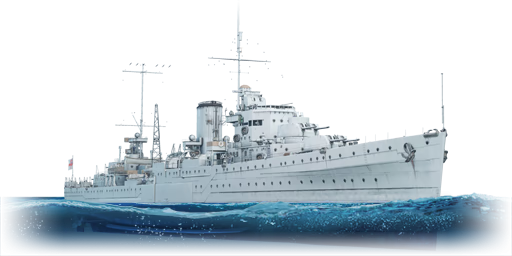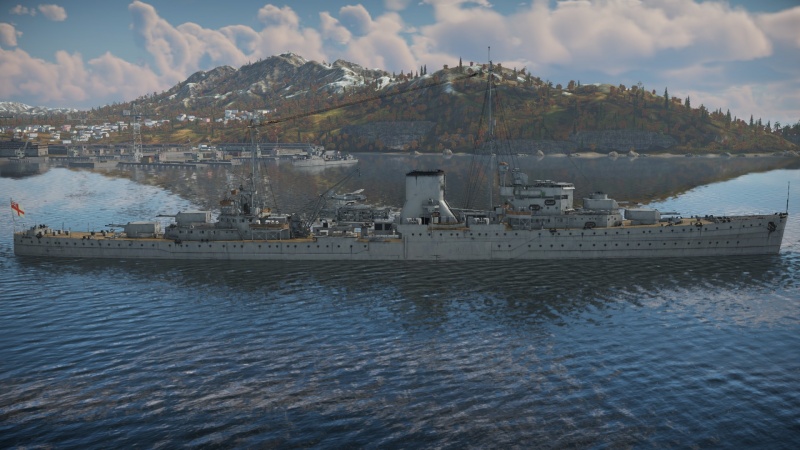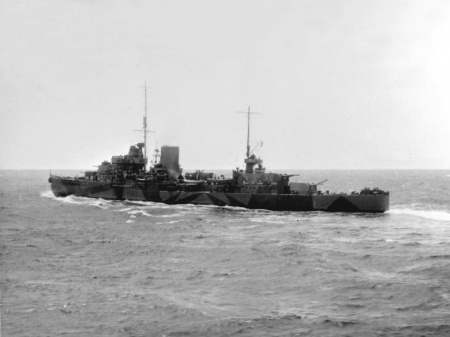Difference between revisions of "HMNZS Leander"
(→Pros and cons) (Tag: Visual edit) |
(Ammunition statistic is wrong for the 6 in CPCBC semi-armor-percing shell) (Tag: Visual edit) |
||
| Line 60: | Line 60: | ||
| 6 inch HE || HE || 37 || 37 || 37 || 37 || 37 || 37 | | 6 inch HE || HE || 37 || 37 || 37 || 37 || 37 || 37 | ||
|- | |- | ||
| − | | 6 inch CPBC || SAPBC || | + | | 6 inch CPBC || SAPBC || 197 || 153 || 115 || 96 || 85 || 77 |
|- | |- | ||
| 6 inch HE-TF || HE-TF || 37 || 37 || 37 || 37 || 37 || 37 | | 6 inch HE-TF || HE-TF || 37 || 37 || 37 || 37 || 37 || 37 | ||
| Line 83: | Line 83: | ||
| 6 inch HE || HE || 841 || 50.8 || 0.02 || 0.1 || 3,960 || 79° || 80° || 81° | | 6 inch HE || HE || 841 || 50.8 || 0.02 || 0.1 || 3,960 || 79° || 80° || 81° | ||
|- | |- | ||
| − | | 6 inch CPBC || SAPBC || 841 || 50.8 || | + | | 6 inch CPBC || SAPBC || 841 || 50.8 || 8 || 7 || 1,870 || 48° || 63° || 71° |
|- | |- | ||
| 6 inch HE-TF || HE-TF || 841 || 50.8 || 0 || 0.1 || 3,960 || 79° || 80° || 81° | | 6 inch HE-TF || HE-TF || 841 || 50.8 || 0 || 0.1 || 3,960 || 79° || 80° || 81° | ||
Revision as of 11:42, 5 July 2021
Contents
Description
The Leander-class, HMNZS Leander (75), 1942 is a rank IV British light cruiser with a battle rating of 5.3 (AB/RB/SB). It was introduced in Update 1.87 "Locked On".
General info
Survivability and armour
Talk about the vehicle's armour. Note the most well-defended and most vulnerable zones, e.g. the ammo magazine. Evaluate the composition of components and assemblies responsible for movement and manoeuvrability. Evaluate the survivability of the primary and secondary armaments separately. Don't forget to mention the size of the crew, which plays an important role in fleet mechanics. Save tips on preserving survivability for the "Usage in battles" section. If necessary, use a graphical template to show the most well-protected or most vulnerable points in the armour.
Mobility
Write about the ship's mobility. Evaluate its power and manoeuvrability, rudder rerouting speed, stopping speed at full tilt, with its maximum forward and reverse speed.
| Mobility Characteristics | |||
|---|---|---|---|
| Game Mode | Upgrade Status | Maximum Speed (km/h) | |
| Forward | Reverse | ||
| AB | |||
| Upgraded | 70 | 30 | |
| RB/SB | |||
| Upgraded | 60 | 26 | |
Modifications and economy
Armament
Primary armament
| 152 mm 6 inch/50 Mark BL XXIII (x8) | |||||
|---|---|---|---|---|---|
| Turrets (Bow to stern) | |||||
| Turret 1 (x2) | Turret 2 (x2) | Turret 3 (x2) | Turret 4 (x2) | ||
| Vertical guidance | -5°/+60° | ||||
| Horizontal guidance | ±145° | ||||
| Total ammo capacity | 1,600 | ||||
Ammunition
| Penetration statistics | |||||||
|---|---|---|---|---|---|---|---|
| Ammunition | Type of warhead |
Penetration @ 0° Angle of Attack (mm) | |||||
| 1,000 m | 2,500 m | 5,000 m | 7,500 m | 10,000 m | 15,000 m | ||
| 6 inch HE | HE | 37 | 37 | 37 | 37 | 37 | 37 |
| 6 inch CPBC | SAPBC | 197 | 153 | 115 | 96 | 85 | 77 |
| 6 inch HE-TF | HE-TF | 37 | 37 | 37 | 37 | 37 | 37 |
| 6 inch HE-VT | HE-VT | 37 | 37 | 37 | 37 | 37 | 37 |
| Shell details | |||||||||
|---|---|---|---|---|---|---|---|---|---|
| Ammunition | Type of warhead |
Velocity (m/s) |
Projectile Mass (kg) |
Fuse delay (m) |
Fuse sensitivity (mm) |
Explosive Mass (TNT equivalent) (g) |
Ricochet | ||
| 0% | 50% | 100% | |||||||
| 6 inch HE | HE | 841 | 50.8 | 0.02 | 0.1 | 3,960 | 79° | 80° | 81° |
| 6 inch CPBC | SAPBC | 841 | 50.8 | 8 | 7 | 1,870 | 48° | 63° | 71° |
| 6 inch HE-TF | HE-TF | 841 | 50.8 | 0 | 0.1 | 3,960 | 79° | 80° | 81° |
| 6 inch HE-VT | HE-VT | 841 | 50.8 | 0 | 0.1 | 3,960 | 79° | 80° | 81° |
Secondary armament
| 102 mm 4 inch/45 Mark XVI (x8) | |||||
|---|---|---|---|---|---|
| Turrets (Bow to stern) | |||||
| Front port turret (x2) | Front starboard turret (x2) | Rear port turret (x2) | Rear starboard turret (x2) | ||
| Vertical guidance | -90°/+80° | -80°/+90° | ±90° | ||
| Horizontal guidance | -10°/+80° | ||||
| Total ammo capacity | 2,000 | ||||
Ammunition
| Penetration statistics | |||||||
|---|---|---|---|---|---|---|---|
| Ammunition | Type of warhead |
Penetration @ 0° Angle of Attack (mm) | |||||
| 1,000 m | 2,500 m | 5,000 m | 7,500 m | 10,000 m | 15,000 m | ||
| 4 inch HE | HE | 20 | 20 | 20 | 20 | 20 | 20 |
| 4 inch SAP | SAP | 101 | 86 | 70 | 60 | 54 | 47 |
| 4 inch HE-TF | HE-TF | 20 | 20 | 20 | 20 | 20 | 20 |
| 4 inch HE-VT | HE-VT | 20 | 20 | 20 | 20 | 20 | 20 |
| Shell details | |||||||||
|---|---|---|---|---|---|---|---|---|---|
| Ammunition | Type of warhead |
Velocity (m/s) |
Projectile Mass (kg) |
Fuse delay (m) |
Fuse sensitivity (mm) |
Explosive Mass (TNT equivalent) (g) |
Ricochet | ||
| 0% | 50% | 100% | |||||||
| 4 inch HE | HE | 811 | 15.88 | 0 | 0.1 | 1,550 | 79° | 80° | 81° |
| 4 inch SAP | SAP | 811 | 17.35 | 3 | 3 | 600 | 47° | 60° | 65° |
| 4 inch HE-TF | HE-TF | 811 | 15.88 | 0 | 0.1 | 1,550 | 79° | 80° | 81° |
| 4 inch HE-VT | HE-VT | 811 | 15.88 | 0 | 0.1 | 1,550 | 79° | 80° | 81° |
Anti-aircraft armament
| 20 mm Oerlikon Mk.II (x5) | |||||
|---|---|---|---|---|---|
| Turrets (Bow to stern) | |||||
| Front turret | Middle port turret | Middle starboard turret | Rear port turret | Rear starboard turret | |
| Vertical guidance | -5°/+65° | -0°/+65° | |||
| Horizontal guidance | ±180 | -60°/+90° | -90°/+60° | ±180 | |
| Total ammo capacity | 9,000 | ||||
| 12.7 mm Vickers Mk.V (x12) | |||
|---|---|---|---|
| Turrets (Bow to stern) | |||
| Front port turret (x4) | Front starboard turret (x4) | Rear turret (x4) | |
| Vertical guidance | +25°/+75° | ||
| Horizontal guidance | ±90° | ||
| Total ammo capacity | 24,000 | ||
Additional armament
| 533 mm steam turbined Mk.V torpedo | ||||||||
|---|---|---|---|---|---|---|---|---|
| # on ship | Mass (kg) | Maximum speed in water (km/h) |
Travel distance (km) | Depth stroke (m) | Arming distance (m) |
Explosive type | Explosive mass (kg) | |
| 8 | 1,736 | 74 | 4.57 | 1.0 | 50 | TNT | 305 | |
Usage in battles
The Leander is very similar to the Arethusa, its predecessor, but has some upgrades over the former. It carries an extra gun turret, giving it an 8-shell broadside which, combined with the 7.5s reload, can give the Leander some dangerous firepower with good accuracy. The good turret traverse and SAP shells make this ship dangerous at close quarters, where it can deal good damage and good penetration to enemy cruisers. It carries the same secondary armament of eight 4-inch guns with four on each broadside, making it a menace for destroyers and larger aircraft. It's also faster than the Arethusa and boasts a larger crew. While the armour is still weak for a cruiser, it's stronger than the Arethusa, with much better protection for the ammo stowage and the gun turrets, as well as some armour for the rudder, which is rare for a light cruiser.
One drawback for the Leander is its weakened AA armament. While it isn't terrible, it's a far cry from the powerful AA screen of the Arethusa, and can leave it vulnerable if it has no friendly ships to offer additional AA fire. The Leander's guns also start to lack at 5.3. Lacking the AP shells of other nations, heavy cruisers can be a real challenge for the Leander, and it struggles to deal good damage at long range as a result.
Pros and cons
Pros:
- Powerful, fast-firing broadside, especially dangerous at close and medium ranges
- Great secondary armament, eight 4-inch guns is dangerous for destroyers and torpedo boats
- Good armour protection, especially around the ammo and guns
- Great turret traverse on main turrets
- Good top speed and manoeuvrability
Cons:
- Average AA armament, weaker than the previous Arethusa
- Armour still isn't enough to save it against heavy cruiser guns
- While the crew is larger than previous cruisers, it's still pretty small
- Big target compared to previous British ships
- No APCBC shells for the 6-inch guns
History
HMNZS / HMS Leander was the lead ship of the eight-ship Leander class, built in the 1930s as a follow-up to the Emerald (E) class. Influenced by the design of the British County-class heavy cruisers, Leander carried a main armament of eight 6-inch guns in dual turrets. Commissioned in 1933, she served under the New Zealand division of the Royal Navy and was eventually given to the New Zealand Navy in 1941, renamed HMNZS Leander. She served in the Indian Ocean and Mediterranean sea during the early days of the Second World War, primarily as a convoy escort. She later served in the Solomon Islands campaign and was hit by a 610 mm torpedo that put her out of service until the end of the war. Following the cessation of hostilities, Leander was repatriated to the UK, and served with the Mediterranean fleet until she was retired in 1948 and scrapped by 1950.
Design and development
The Leander-class cruisers originated as a successor to the British Emerald (or E) class, as the first class of light cruisers built by the United Kingdom since the end of the First World War. Influenced by the designs of the County and York classes of heavy cruisers, the Leander class had a similar hull design and gun arrangement. However, displacing 7270 tons standard, they were significantly lighter. Leander’s powerful steam turbines allowed her to reach a top speed of almost 33 knots (61 km/h), but their large size meant that she had relatively low armour protection compared to her peers - up to 3 inches (76 mm) of armour at the magazines, and far less throughout the vessel.
Leander carried a main armament of eight 6-inch (152 mm) BL Mk 23 guns mounted in four twin turrets, similar to the layout of the County-class heavy cruisers. She also carried a secondary armament of four single 4-inch (102 mm) dual-purpose guns, though these were upgraded to dual turrets later in her career. Her initial anti-aircraft armament was also rather sparse, composed of just three quadruple Vickers machine guns (calibre 12.7 mm); this was also upgraded significantly in her later service. Leander, the first ship of her class, was laid down in February of 1930; following completion, she was commissioned in 1933.
Operational history
Following her completion, the Leander served in the New Zealand division of the Royal Navy, along with her sister ship Achilles. Back then, the defence of New Zealand’s naval territory was conducted by the Royal Navy, and as a result, the ships were operated by the Royal Navy until the formation of the New Zealand navy in 1941. She participated in the Coronation Review of 1937, and later conducted an aerial survey of the south Pacific ocean. During the time before the war, she toured ports in New Zealand, and also participated in exercises in Australian and British waters.
Following the outbreak of the Second World War, Leander travelled to the port of Alexandria, in the Mediterranean. She was intended to serve in the British mediterranean fleet, but these plans were changed when she was instead given to the British East Indies squadron. During this period, she escorted convoys in the Red sea area and sank several vessels, including an Italian submarine and merchant raider.
In early 1941, Leander was formally given to the New Zealand Navy, which had been formed as an independent naval force. She was then reassigned to the Mediterranean squadron to replace several cruisers that had been destroyed. During this time, she participated in the Syria-Lebanon campaign, fighting against the Vichy French naval forces stationed in that area. After this action, Leander departed as an escort for a convoy bound for Australia, arriving in September of 1941.
In early 1942, with the Japanese raid on Pearl harbour and subsequent declaration of war, Leander began serving in the Pacific theatre. She escorted convoys during the Solomons campaign but was dry docked for several months when a crack was found in her hull. She was returned to service in March of 1943, replacing the sunken cruiser Helena in the Solomon campaign. It was there in July of 1943 when, during a short engagement with Japanese naval forces, Helena was hit by a 610 mm “long lance” torpedo. The damage was extreme, yet she survived and limped to port for repairs. In fact, the damage was extensive enough that she was taken out of service for the rest of the war. By late 1944, Leander had been paid off from the New Zealand Navy, most of her crew members going to her sister ship HMNZS Achilles. Following the completion of repairs, she was repatriated to the UK in late 1945. She saw little service, and was used as a target ship in 1948 before being scrapped by 1950.
Devblog
The Leander-class light cruisers were designed in the late 1920s under the influence of the York-class heavy cruisers. However, the Leander-class differed from previous light cruisers by placing a higher emphasis on seaworthiness and operating range, rather than on protection and firepower. This was done with the aim to make the Leander-class light cruisers more suitable for the commerce protection role.
Initially, five ships of the Leander-class were ordered in the early 1930s, with HMS Leader as the lead ship being laid down in September 1930. Leander was completed a year later and commissioned into service in March 1933. Initially, the warship served with the New Zealand Division of the Royal Navy, before being transferred to the Royal New Zealand Navy after its formation in 1941. From there onwards, the ship sailed under its new designation HMNZS Leander.
Leander primarily served in the Pacific theatre during WW2, taking part in several smaller operations during her early service life. Leander was also briefly stationed in the Mediterranean, supporting allied troops in actions against Vichy France during the Syria-Lebanon campaign. After that, Leander once again returned to the Pacific, where she was severely damaged after an engagement with a small Japanese task force in July 1943. The damage suffered from a torpedo hit was so severe that it rendered Leander inoperable for the remainder of the war, until she was repaired in August 1945.
HMNZS Leander only had a very short post-war service life. The warship was officially decommissioned in 1948 and sold for scrap in 1950.
Media
Excellent additions to the article would be video guides, screenshots from the game, and photos.
See also
Links to articles on the War Thunder Wiki that you think will be useful for the reader, for example:
- reference to the series of the ship;
- links to approximate analogues of other nations and research trees.
External links
References:
- New Zealand History. (2020). HMNZS Leander. Retrieved January 04, 2021, from https://nzhistory.govt.nz/war/hmnzs-leander
- National Museum of the New Zealand Navy. (2020, June 08). Leander. Retrieved January 07, 2021, from https://navymuseum.co.nz/explore/by-collections/ships/leander/
| Britain light cruisers | |
|---|---|
| Emerald-class | HMS Enterprise |
| Dido-class | HMS Dido |
| Leander-class | HMNZS Leander |
| Arethusa-class | HMS Arethusa |
| Town-class | HMS Belfast · HMS Liverpool · HMS Southampton |
| Tiger-class | HMS Tiger |
| Abdiel-class* | HMS Abdiel |






